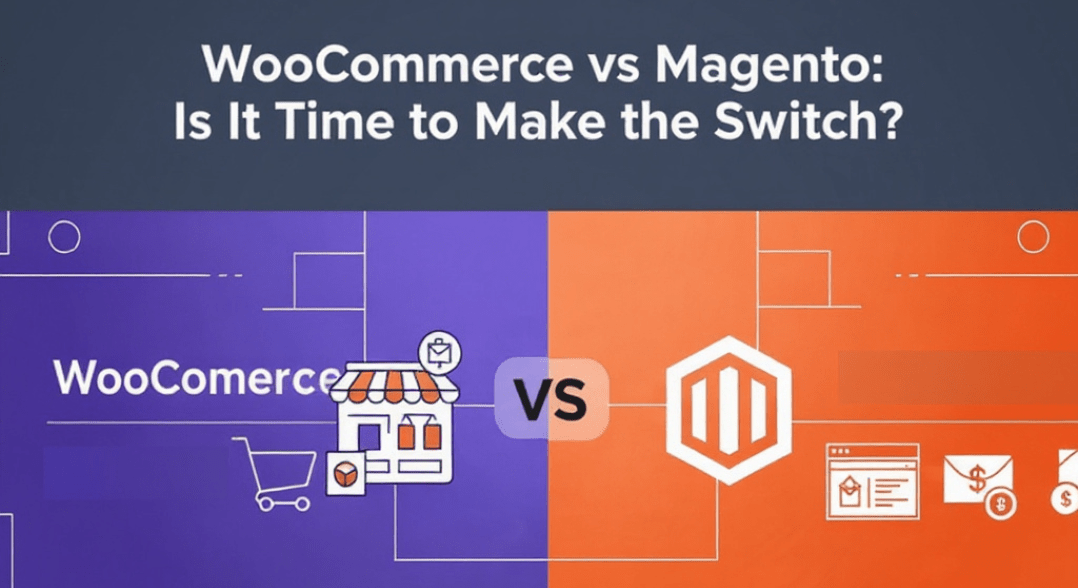Thinking of upgrading your eCommerce platform? WooCommerce is simple and flexible, while Magento offers scalability and advanced features for growing stores. If your business is hitting limits with WooCommerce, it might be time to switch to Magento. Evaluate your needs for performance, customization, and security. Make the transition smooth with expert guidance from SMB Tech Solution.
Your eCommerce platform isn’t just a tool—it’s the engine of your online business. The wrong choice can slow you down, cost you money, and even push customers away. That’s why the debate of WooCommerce vs Magento isn’t just about features—it’s about growth, scalability, and survival in a competitive market.
If you’ve ever asked yourself “Should I stick with WooCommerce or is it time to move to Magento?”—this article will hit those trigger points and give you the clarity you need.
WooCommerce: The Comfort Zone That Works—Until It Doesn’t
WooCommerce is the world’s most popular WordPress plugin, powering millions of online stores. It’s easy, affordable, and gets you selling quickly.
But here’s the truth: WooCommerce is built for starters, not scale.
- Perfect for small to mid-sized businesses
- Great if you rely on WordPress SEO & content marketing
- Cost-effective with plugins and themes
- Easy for non-technical store owners
🚀 Trigger Point: If you’re under 1,000 products and have modest traffic, WooCommerce is enough. But once your store starts growing, those plugins start stacking up, page speeds drop, and your once “simple” store becomes a maintenance headache.
Magento: The Powerhouse Built for Growth
Magento (now Adobe Commerce) is a beast—complex, robust, and unstoppable when handled right. It’s not the plug-and-play solution WooCommerce is, but that’s because it’s engineered for serious eCommerce growth.
- Handles 10,000+ products without breaking a sweat
- Runs multiple stores, currencies, and languages from one dashboard
- Rock-solid inventory and order management
- Designed for high traffic, high conversion websites
- Packed with B2B features like bulk ordering and custom pricing
⚡ Trigger Point: If you’re scaling fast and WooCommerce is choking your growth, Magento isn’t just an upgrade—it’s your lifeline.
WooCommerce vs Magento: When to Switch

Here’s the brutal truth: sticking with the wrong platform costs more than switching.
👉 Stay on WooCommerce if:
- You’re small-to-mid size with under ~1,000 products
- Your growth is steady, not explosive
- You want ease of use with low technical requirements
👉 Switch to Magento if:
- Your site crashes under high traffic spikes
- You’re running multiple stores/markets
- You need enterprise-level features out-of-the-box
- You’re tired of patching WooCommerce with endless plugins
- You’re losing sales because of speed or checkout limitations
The Migration Dilemma
Yes, migration from WooCommerce to Magento requires investment. But think about this:
- How much are slow speeds, abandoned carts, and plugin conflicts costing you?
- Are you spending more fixing WooCommerce than you would investing in a solid Magento store?
- Will WooCommerce still serve you in 2 years—or will it hold you back?
💡 The best businesses don’t wait until it’s too late. They switch platforms before growth becomes a bottleneck.
Final Verdict: WooCommerce vs Magento
- WooCommerce is your go-to for starting out, growing small-to-mid-size, and keeping costs low.
- Magento is your upgrade path when you’re ready to dominate at scale, expand globally, or need advanced B2B functionality.
🔥 Here’s the trigger: If your store has already outgrown WooCommerce, every day you delay switching to Magento, you’re leaving money on the table.
The question isn’t “WooCommerce vs Magento—Which is better?”
The real question is: “When will YOU be ready to switch?”

